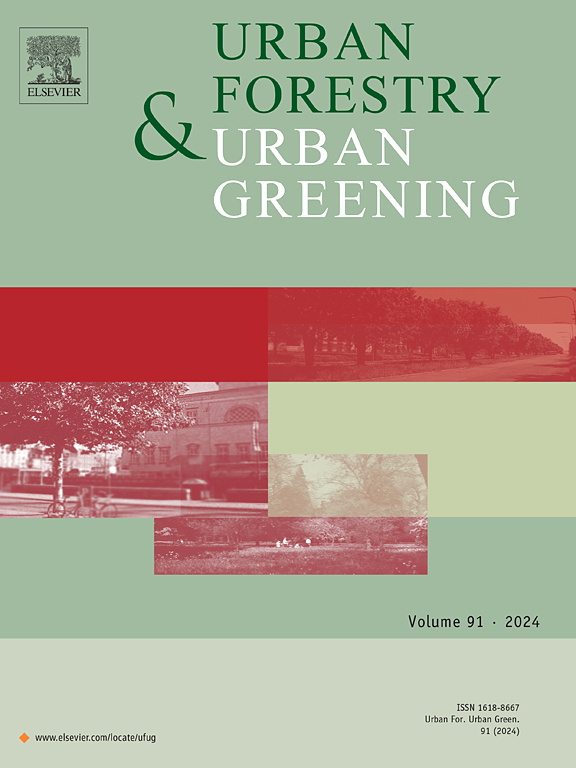城市绿地支持移民社会融合?瑞典的案例研究
IF 6
2区 环境科学与生态学
Q1 ENVIRONMENTAL STUDIES
引用次数: 0
摘要
在过去十年中,移民成功融入欧洲社会已成为一个关键的政策问题。城市绿地(UGS)为不同种族背景的人们提供社交空间;然而,移民与接收社会的社会融合与UGS之间的关系引起了相对较少的研究兴趣。本研究旨在探讨UGS在促进瑞典第一代移民(“新瑞典人”)社会融合方面的作用,重点关注社会融合的四种形式:结构、互动、文化和认同。我们对来自瑞典九个城市定居点的280名新瑞典人进行了采访。我们的研究结果表明,瑞典的UGS为来自不同文化(包括接收社会)的人们提供了多种互动融合的机会,UGS的可及性、质量和可用性对结构融合至关重要。虽然UGS主要不是作为发展新瑞典人和本地人之间新关系的场所,但它们确实促进了家庭和文化社区之间的社会互动。此外,UGS让新瑞典人接触到瑞典关于户外娱乐的文化规范。我们的研究结果强调了关键基础设施在促进社会互动和融合方面的重要性。移民在UGS规划和管理中的积极作用将确保他们的需求和利益在UGS设计中得到考虑,并为更好地与接收社会联系提供重要机会。最后,了解UGS的潜在贡献还需要了解这种整合的程度和深度。本文章由计算机程序翻译,如有差异,请以英文原文为准。
Urban greenspace to support social integration of immigrants? Case studies across Sweden
The successful integration of immigrants into European societies has become a crucial policy issue in the past decade. Urban greenspace (UGS) provides social spaces for people with different ethnic backgrounds; however, the relationships between the social integration of immigrants with the reciving society and UGS have attracted relatively little research interest. This study aims to explore the role of UGS in enhancing the social integration of first-generation immigrants in Sweden (“new- Swedes”) by focusing on four forms of social integration: structural, interactive, cultural, and identificational. We draw on a sample of 280 interviews with new-Swedes from nine urban settlements in Sweden. Our results show that UGS in Sweden provides multiple opportunities for interactive integration among people from diverse cultures, including the receiving society, and that the accessibility, quality, and availability of UGS are crucial for structural integration. Although UGS do not primarily serve as venues for developing new relationships between new and native Swedes, they do facilitate social interactions within families and cultural communities. Additionally, UGS expose new Swedes to Swedish cultural norms regarding outdoor recreation. Our findings underscore the importance of critical infrastructure in promoting social interaction and integration. Active roles of immigrants in UGS planning and management will ensure that their needs and interests are considered in UGS design and offer important opportunities to be better connected to the receiving society. Finally, understanding the potential contribution of UGS also requires understanding the extent and depth of such integration.
求助全文
通过发布文献求助,成功后即可免费获取论文全文。
去求助
来源期刊

Urban Forestry & Urban Greening
FORESTRY-
CiteScore
11.70
自引率
12.50%
发文量
289
审稿时长
70 days
期刊介绍:
Urban Forestry and Urban Greening is a refereed, international journal aimed at presenting high-quality research with urban and peri-urban woody and non-woody vegetation and its use, planning, design, establishment and management as its main topics. Urban Forestry and Urban Greening concentrates on all tree-dominated (as joint together in the urban forest) as well as other green resources in and around urban areas, such as woodlands, public and private urban parks and gardens, urban nature areas, street tree and square plantations, botanical gardens and cemeteries.
The journal welcomes basic and applied research papers, as well as review papers and short communications. Contributions should focus on one or more of the following aspects:
-Form and functions of urban forests and other vegetation, including aspects of urban ecology.
-Policy-making, planning and design related to urban forests and other vegetation.
-Selection and establishment of tree resources and other vegetation for urban environments.
-Management of urban forests and other vegetation.
Original contributions of a high academic standard are invited from a wide range of disciplines and fields, including forestry, biology, horticulture, arboriculture, landscape ecology, pathology, soil science, hydrology, landscape architecture, landscape planning, urban planning and design, economics, sociology, environmental psychology, public health, and education.
 求助内容:
求助内容: 应助结果提醒方式:
应助结果提醒方式:


